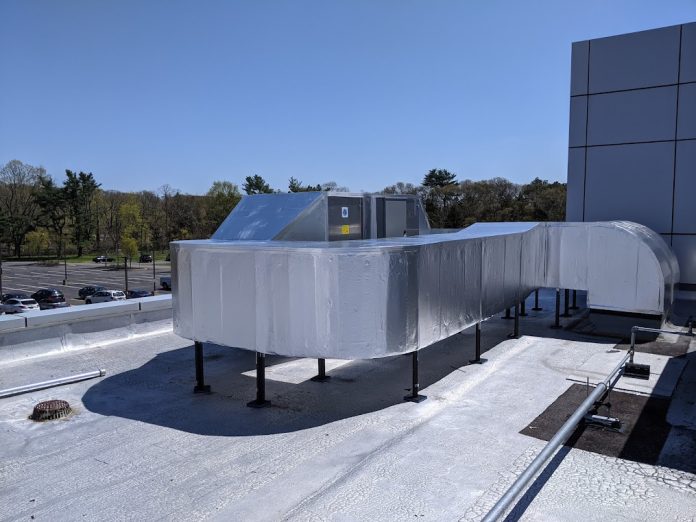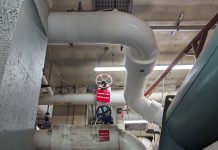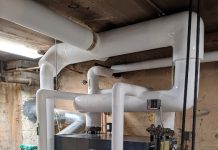MECHANICAL INSULATION is defined to encompass all thermal, acoustical, and personnel safety requirements in:
a. Mechanical piping and equipment, hot and cold
applications
b. Heating, Ventilating, and Air Conditioning (HVAC) applications
c. Refrigeration and other low-temperature piping and equipment applications
Mechanical insulation in the BUILDING SECTOR is defined to include education, health care, institutional, retail and wholesale, office, food processing, light manufacturing, and similar applications. This is often referred to as the commercial sector.
Mechanical insulation in the INDUSTRIAL SECTOR is defined to include power, petrochemical, chemical, pulp and paper, refining, gas processing, brewery, heavy manufacturing, and similar applications.
So what does this mean? Basically, mechanical insulation is used to insulate equipment or processes, as opposed to building envelope insulation, which is found in walls and roofs. You will also find mechanical insulation on ductwork and piping, in addition to equipment used in industrial processes.
Insulation is manufactured from a variety of materials, including cellular, fibrous, flake, granular, and reflective. Mechanical insulation is used on both high- and low-temperature applications and serves a number of functions, including protecting workers from burns on hot surfaces, lessening noise on air-handling systems (for occupant productivity and comfort in offices, for example), and maintaining the temperature of a substance in pipes or equipment to prevent more energy being used to re-heat or re-cool it when it reaches its destination.
The Best-Kept Secret
The mechanical insulation industry has a long track record of providing large scale and long-term energy efficiency, emissions reductions, cost savings, and safety benefits at manufacturing facilities, power plants, refineries, hospitals, universities, and government buildings. So why is mechanical insulation “the forgotten technology” when it comes to energy efficiency?
Currently “green” rating systems such as LEED certification do not allow mechanical insulation to be used on a stand-alone basis for credits. The American Society of Heating, Refrigerating, and Air-Conditioning Engineers (ASHRAE) 90.1 standard sets the minimum requirements for mechanical insulation, but the minimum levels of insulation do not always make the most economic sense. Frequently, insulating beyond the minimum requirements leads to a building that uses less energy over its lifetime. Sometimes it even permits a smaller heating or cooling system because it adds so much efficiency.
NIA recently conducted a study of mechanical insulation use in schools and hospitals, two common types of commercial buildings. For the schools studied, it is estimated that mechanical insulation saves, on average, 13 kBtu/sf/yr of site energy (about 20 percent of the total usage). For hospitals, the energy savings from mechanical insulation are estimated to average about 149 kBtu/sf/yr (roughly 78 percent of the total site energy usage). These large numbers highlight the importance of mechanical insulation in commercial buildings. In fact, it can be argued that some of the energy distribution systems in commercial buildings could not function without mechanical insulation because distribution losses would become excessive. The importance of properly maintaining the insulation on these distribution systems is evident.
Mechanical insulation is usually hidden behind walls or ceilings in commercial buildings, though it is often easier to spot in industrial facilities. The old adage “out of sight, out of mind” applies, and NIA estimates that between 10 and 30 percent of installed mechanical insulation is damaged or missing. Without regular inspection and maintenance, insulation cannot live up to its energy efficiency potential. Even in industrial facilities, it is not uncommon to see uninsulated valves and places where insulation has been removed to inspect the substrate and not replaced. These un-insulated components can significantly impact a facility’s energy use and costs. Using government data, NIA estimated that maintenance of insulation at industrial facilities alone can generate more than $3.6 billion in energy savings per year, reduce 83 billion pounds of CO2 and other greenhouse gas emissions, and create more than 27,000 jobs annually.
In an appraisal of state facilities in Montana, NIA discovered how valuable repairing or replacing mechanical insulation can be. Approximately 3,500 un- or under-insulated items were identified in 25 buildings (56 mechanical rooms), with estimated energy savings of approximately 6 billion Btu per year, a resulting overall payback period of 4.1 years, and an annualized rate of return of 24 percent. Associated reductions in CO2 emissions are estimated at 300 metric tonnes per year. On a square foot of gross building area basis, the energy savings averaged 4.6 kBtu/sf/yr, while energy cost savings averaged $0.043/sf.
Mechanical insulation and insulation in general are among the few industrially manufactured products that save more energy over their life span than is required for their manufacturing. NIA has estimated that some mechanical insulation systems save more than 140 and up to 500 times more energy over their life spans (20 years) than it takes to produce them. This is based on performance comparison of surfaces with and without insulation. Mechanical insulation can also save a minimum of 150 (and up to 750) times more CO2 emissions than it takes to produce the insulation product.





